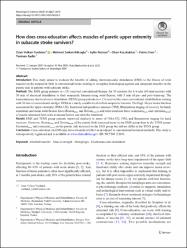| dc.contributor.author | Yurdakul, Ozan Volkan | |
| dc.contributor.author | Kılıçoğlu, Mehmet Serkan | |
| dc.contributor.author | Rezvani, Aylin | |
| dc.contributor.author | Küçükakkaş, Okan | |
| dc.contributor.author | Eren, Fatma | |
| dc.contributor.author | Aydın, Teoman | |
| dc.date.accessioned | 2020-12-01T06:42:34Z | |
| dc.date.available | 2020-12-01T06:42:34Z | |
| dc.date.issued | 2020 | en_US |
| dc.identifier.citation | Yurdakul, O. V., Kılıçoğlu, M. S., Rezvani, A., Küçükakkaş, O., Eren, F. ve Aydın, T. (2020). How does cross-education affects muscles of paretic upper extremity in subacute stroke survivors? Neurological Sciences, 41(12), 3667-3675. https://dx.doi.org/10.1007/s10072-020-04506-2 | en_US |
| dc.identifier.issn | 1590-1874 | |
| dc.identifier.issn | 1590-3478 | |
| dc.identifier.uri | https://dx.doi.org/10.1007/s10072-020-04506-2 | |
| dc.identifier.uri | https://hdl.handle.net/20.500.12511/6062 | |
| dc.description.abstract | Introduction This study aimed to evaluate the benefits of adding electromuscular stimulation (EMS) to the flexors of wrist muscles on the nonparetic limb in conventional stroke training to strengthen homologous agonist and antagonist muscles on the paretic side in patients with subacute stroke. Methods The EMS group patients (n = 15) received conventional therapy for 30 sessions for 6 weeks (60 min/session) with 30 min of electrical stimulation to their nonparetic forearm using wrist flexors, with 5 min of pre- and post-warm-up. The transcutaneous electrical nerve stimulation (TENS) group patients (n = 15) received the same conventional rehabilitation training with 30 min of conventional antalgic TENS at a barely sensible level to their nonparetic forearm. The Fugl-Meyer motor function assessment for upper extremity (FMA-UE), functional independence measure (FIM), Brunnstrom staging of recovery for hand, maximum and mean wrist flexion force (flexion(max) and flexion(mean)), and wrist extension force (extension(max) and extension(mean)) of paretic untrained limb were evaluated before and after the treatment. Results EMS and TENS group patients improved similarly in terms of FMA-UE, FIM, and Brunnstrom staging for hand recovery. However, flexion(max) and flexion(mean) of the paretic limb increased more in the EMS group than in the TENS group. Extension(max) and extension(mean) on the paretic side increased in the EMS group but did not differ in the TENS group. Conclusion Cross-education via EMS may have a beneficial effect as an adjunct to conventional treatment methods. This study is retrospectively registered and is available at (ID: NCT04113369). | en_US |
| dc.description.sponsorship | Coordinatorship of Scientific Research Projects of Bezmialem University | en_US |
| dc.language.iso | eng | en_US |
| dc.publisher | Springer-Verlag Italia S.R.L. | en_US |
| dc.rights | info:eu-repo/semantics/embargoedAccess | en_US |
| dc.subject | Interlimb Transfer | en_US |
| dc.subject | Muscle Strength | en_US |
| dc.subject | Hemiplegia | en_US |
| dc.subject | Electromuscular Stimulation | en_US |
| dc.title | How does cross-education affects muscles of paretic upper extremity in subacute stroke survivors? | en_US |
| dc.type | article | en_US |
| dc.relation.ispartof | Neurological Sciences | en_US |
| dc.department | İstanbul Medipol Üniversitesi, Tıp Fakültesi, Dahili Tıp Bilimleri Bölümü, Fizik Tedavi ve Rehabilitasyon Ana Bilim Dalı | en_US |
| dc.authorid | 0000-0002-5852-3854 | en_US |
| dc.identifier.volume | 41 | en_US |
| dc.identifier.issue | 12 | en_US |
| dc.identifier.startpage | 3667 | en_US |
| dc.identifier.endpage | 3675 | en_US |
| dc.relation.publicationcategory | Makale - Uluslararası Hakemli Dergi - Kurum Öğretim Elemanı | en_US |
| dc.identifier.doi | 10.1007/s10072-020-04506-2 | en_US |
| dc.identifier.wosquality | Q2 | en_US |
| dc.identifier.scopusquality | Q2 | en_US |


















